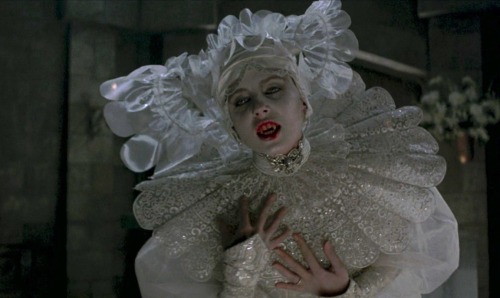I read “Kiss Me with those Red Lips” to supplement my blog, and it added a whole new layer of information to my views about sexuality in Dracula. It talked about gender roles in the story. Men have power, and its “active, progressive, and defensive…. His intellect is for speculation and invention; his energy for adventure, for war and for conquest.” In the book, we see that as the men are the ones who fight Dracula and receive the credit. “Women [bear] a different burden, she must be … incorruptibly good… infallibly wise- not for self-development, but for self-renunciation.” (109) These core facts about how women and men were supposed to act and how they were seen definitely help my understanding of why the characters are portrayed thusly.
Dracula, then, is the corrupter, bringing about danger and neck sucking. Dracula threatens the order of society. The article makes a claim that “vampirism is an excellent example of the identity of desire and fear.” (107) The vampire bite itself is a mix of the traditional male vs. female characteristics. Beginning with the soft lips of the vampire and ending up with the pointy teeth and the bite, like the promise of the sweet actions more traditionally associated with females, but then ending up with a bite which is linked more towards the attributes of a man. Dracula seems to try to bring about change from the perceived gender roles, making women after they have been bitten more overt and outspoken.
With this mix up, men have to brave up and save the day, killing all the vampires and having women revert to their prescribed gender roles. But it is the association that this outside corrupter that turns women into “monsters,” that really makes the modern reader have to think about prescribed gender roles now, and back in the 19th century.
 ition, she becomes increasingly sexualised because her suppressed sexuality is becoming more obvious and transparent as well as becoming the sexual aggressor, which in 1897, was not the norm. Women were supposed to accept their husband’s sexual needs and expectations but never act on their own. Throughout the novel a sca
ition, she becomes increasingly sexualised because her suppressed sexuality is becoming more obvious and transparent as well as becoming the sexual aggressor, which in 1897, was not the norm. Women were supposed to accept their husband’s sexual needs and expectations but never act on their own. Throughout the novel a sca le was set, Mina on one end, representing the ideal Victorian woman with traditional ideals and Dracula’s three daughters on the other end, depicting the Victorian idea
le was set, Mina on one end, representing the ideal Victorian woman with traditional ideals and Dracula’s three daughters on the other end, depicting the Victorian idea  of evil and impurity mostly shown with their hyper-sexuality and vampirism and as Stoker made clear that vampires are evil, then therefore so are hyper-sexual women.
of evil and impurity mostly shown with their hyper-sexuality and vampirism and as Stoker made clear that vampires are evil, then therefore so are hyper-sexual women.